Scania AB Bundle
Who are Scania's Customers in Today's Evolving Transport Landscape?
In an era defined by sustainable transport, understanding the Scania AB SWOT Analysis customer demographics and target market is crucial for long-term success. Scania, a leader in the trucking industry, faces a rapidly changing market where customer needs are evolving. This analysis delves into the core of Scania's business, exploring its customer base to understand its strategies.
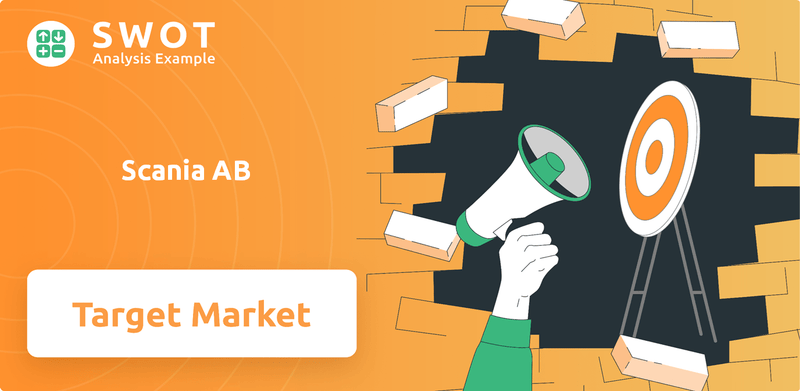
This comprehensive exploration of Scania AB's customer profile will reveal the specific needs and preferences driving purchasing decisions within the commercial vehicles sector. We'll examine the company's market segmentation strategies, dissecting the characteristics of its target audience, including factors like customer age range, income levels, and industry sectors. Furthermore, the analysis will cover Scania's sales strategies, global customer base, and purchasing behavior, offering insights into how Scania maintains its competitive edge in the heavy-duty vehicle market.
Who Are Scania AB’s Main Customers?
Understanding the primary customer segments is crucial for analyzing the business strategy of Scania AB. As a Business-to-Business (B2B) company, Scania focuses on commercial clients rather than individual consumers. This focus shapes its product offerings and marketing approaches, targeting specific needs within the commercial vehicle market. The company's success hinges on meeting the demands of these key customer groups, ensuring reliability, efficiency, and durability in their transport solutions.
The core customer base for Scania includes a diverse array of sectors. These include large logistics and transportation companies, public transport authorities, construction firms, and mining operations. Each segment has unique requirements, such as fleet size, operational routes, and cargo types, which influence their purchasing decisions. Scania tailors its products and services to meet these varying needs, ensuring it remains competitive in the global commercial vehicle market.
Scania's ability to adapt to evolving market trends is also critical. The increasing demand for sustainable transport solutions has led to a growing segment of customers interested in alternative fuel vehicles and electric trucks and buses. This shift is driven by environmental regulations and corporate sustainability goals. In 2023, Scania delivered 96,727 vehicles, reflecting a strategic shift towards sustainable transport.
Logistics and long-haul transportation companies represent a significant portion of Scania's revenue. These companies require reliable and efficient vehicles to meet the continuous demand for global goods movement. Scania provides a range of trucks and services designed to optimize operational efficiency and reduce downtime, which is crucial for these customers.
Public transport operators are another crucial segment, particularly as cities invest in sustainable and efficient bus systems. Scania offers a variety of buses, including those powered by alternative fuels and electric models, to meet the needs of these customers. This segment is driven by the need for environmentally friendly and cost-effective public transportation solutions.
Construction and mining firms require robust and heavy-duty vehicles capable of withstanding demanding operational environments. Scania's specialized vehicles are essential for these applications, providing durability and reliability. These customers often operate in challenging terrains and require vehicles designed for heavy loads and continuous operation.
With increasing environmental awareness, Scania has seen a growing segment of customers interested in alternative fuel vehicles and electric trucks and buses. This segment is driven by evolving environmental regulations and corporate sustainability goals. The company's focus on sustainable transport solutions is evident in its product portfolio and sales strategies.
Scania's customer profile analysis reveals that while traditional demographic data is less relevant in the B2B context, key characteristics are crucial. These include fleet size, operational routes, cargo type, and regulatory compliance requirements. Understanding these factors helps Scania tailor its products and services effectively.
- Fleet Size: The number of vehicles a customer operates influences the scale of their needs and the type of vehicles they require.
- Operational Routes: Long-haul versus local routes determine the specifications needed, such as fuel efficiency and engine power.
- Cargo Type: The nature of the goods transported impacts vehicle choice, including weight capacity and specialized features.
- Regulatory Compliance: Adherence to environmental and safety regulations influences purchasing decisions and vehicle specifications.
Scania AB SWOT Analysis
- Complete SWOT Breakdown
- Fully Customizable
- Editable in Excel & Word
- Professional Formatting
- Investor-Ready Format
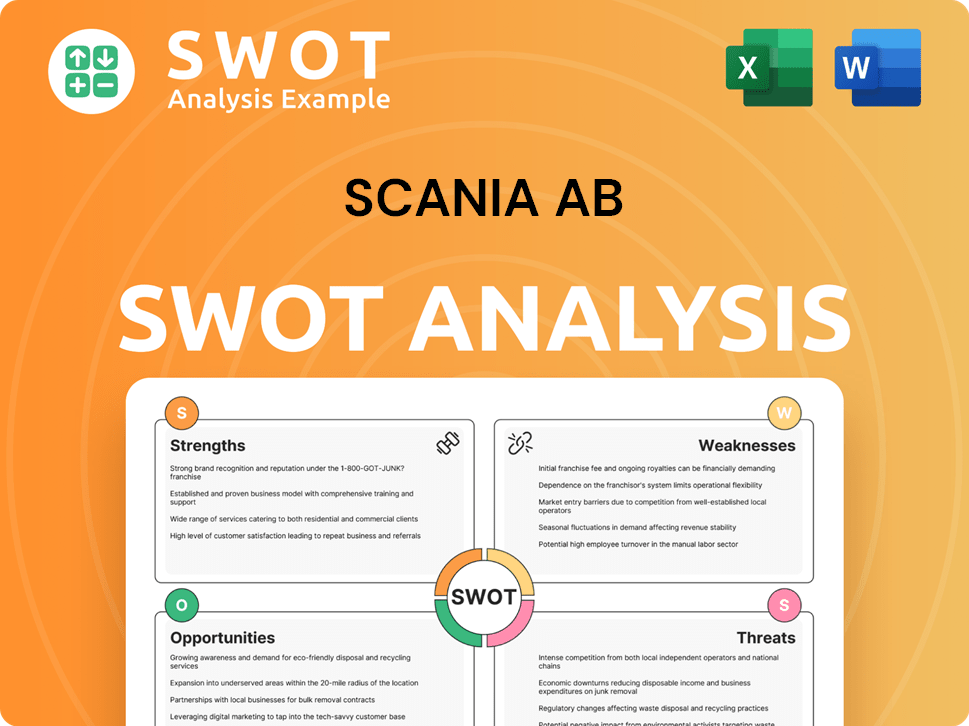
What Do Scania AB’s Customers Want?
Understanding the customer needs and preferences is crucial for the success of any company, and for Scania AB, this involves a deep dive into the factors influencing purchasing decisions within the Growth Strategy of Scania AB. Scania's customers, operating in the competitive trucking industry and commercial vehicles sectors, have diverse needs. These needs are shaped by practical, economic, and increasingly, environmental considerations.
The primary focus for Scania's customers revolves around vehicle uptime and reliability, fuel efficiency, and the total cost of ownership (TCO). These factors are paramount in a business where every minute of downtime translates to financial losses. Additionally, safety features and driver comfort play a significant role in the decision-making process. Customers also consider brand reputation and the perceived value of a long-term partnership with Scania.
Aspirational drivers are also gaining prominence, particularly concerning sustainability goals. Many companies are seeking to reduce their carbon footprint and enhance their public image by investing in greener transport solutions. Scania's response to these evolving needs is evident in its product offerings and strategic initiatives.
Scania addresses the diverse needs of its customers through a range of offerings and strategic initiatives. This includes providing modular vehicle systems that allow for customization, comprehensive service contracts, and advanced telematics systems for fleet management. These solutions are designed to enhance operational efficiency and reduce costs for customers.
- Uptime and Reliability: Scania's robust vehicle designs and extensive service network are crucial for minimizing downtime. In 2024, Scania reported a 98% customer satisfaction rate for its service contracts, highlighting the importance of reliability.
- Fuel Efficiency: The launch of the Super powertrain in 2021, delivering 8% fuel savings, directly addresses a key customer concern. In 2024, Scania's average fuel consumption across its fleet was 25.5 liters per 100 km, a significant improvement compared to older models.
- Total Cost of Ownership (TCO): Scania's focus on TCO includes not only the purchase price but also maintenance, repairs, and fuel consumption. The company's financial reports for 2024 show that customers who utilize Scania's service contracts experience a 15% reduction in overall operating costs.
- Sustainability: Responding to the growing demand for sustainable solutions, Scania has accelerated the development and rollout of electric trucks and buses. By the end of 2024, Scania had delivered over 1,500 electric vehicles globally, with plans to increase production by 40% in 2025.
Scania AB PESTLE Analysis
- Covers All 6 PESTLE Categories
- No Research Needed – Save Hours of Work
- Built by Experts, Trusted by Consultants
- Instant Download, Ready to Use
- 100% Editable, Fully Customizable
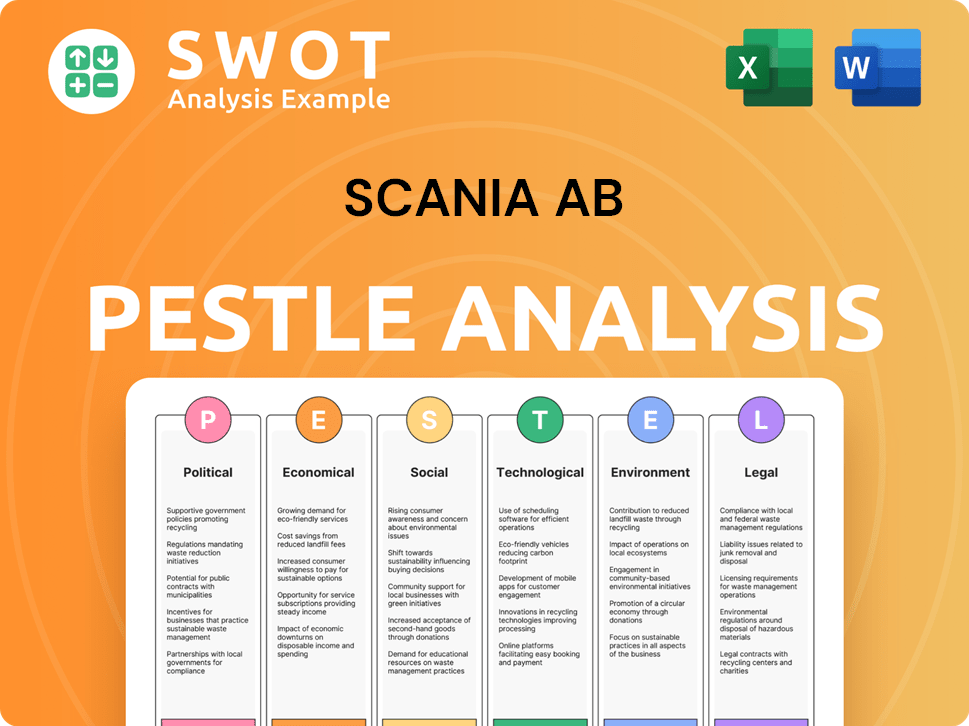
Where does Scania AB operate?
The geographical market presence of Scania AB is substantial, with a strategic focus on key regions worldwide. Europe, Latin America, and parts of Asia are the primary areas where the company concentrates its efforts. This strategic distribution allows Scania to cater to a diverse range of customer needs and market dynamics, maximizing its global reach and market share within the commercial vehicles sector.
Europe serves as a cornerstone for Scania, boasting strong brand recognition and a significant market share. Countries like Germany, France, the UK, and the Nordic nations are particularly crucial, driving sales of both trucks and buses. In Latin America, Brazil holds a dominant position, supported by a long-standing manufacturing presence and a solid customer base in the heavy truck segment. Asia represents a key growth area, especially in emerging markets like China and India, where infrastructure development and rising demand for commercial vehicles are fueling expansion.
Scania's approach involves tailoring its offerings to meet regional needs. This includes adapting vehicle specifications to local regulations, establishing localized service networks, and customizing marketing messages to resonate with cultural nuances. For instance, Scania offers a range of engine options to accommodate varying fuel qualities and availability, and develops specific vehicle configurations for challenging terrains. This localized strategy helps the company maintain its competitive edge and customer satisfaction across diverse markets.
Scania segments its markets based on geographical regions, customer demographics, and specific industry needs. This allows for targeted sales and marketing strategies. Understanding the Scania AB target market is crucial for effective product positioning and customer engagement.
Europe, Latin America, and Asia are the primary geographical markets for Scania. Each region presents unique challenges and opportunities. Scania AB market share by region varies, reflecting the company's strategic focus and market penetration efforts.
Customer demographics vary across regions, influencing vehicle preferences and purchasing behaviors. European customers often prioritize emission standards and safety, while those in emerging markets may focus on robustness and cost-effectiveness. Understanding Scania AB customer profile analysis is essential.
Scania employs localized sales strategies, including tailored marketing and service networks. This approach helps in meeting the specific needs of each market. Scania AB sales strategies for target markets are designed to maximize customer satisfaction and market share.
The differences in customer demographics, preferences, and purchasing power are evident across these regions. For example, while European customers often prioritize advanced emission standards and safety features, customers in some emerging markets might place a greater emphasis on vehicle robustness and cost-effectiveness. Scania localizes its offerings by adapting vehicle specifications to regional regulations, providing localized service networks, and tailoring marketing messages to cultural nuances. This includes offering a wider range of engine options to suit varying fuel quality and availability, and developing specific vehicle configurations for challenging terrains. In 2023, Scania's net sales in Europe and Africa amounted to SEK 87,419 million, while in South America, net sales reached SEK 36,929 million, highlighting the significant contributions from these regions. The company's strategic focus on sustainable transport solutions also leads to targeted market entry strategies in regions with strong governmental support for green initiatives, such as several European countries.
Scania's global presence is strategically managed to address diverse market needs. The company’s success is rooted in adapting to local conditions and customer preferences. For more detailed insights, explore the analysis of Scania AB's customer base.
- Europe is a stronghold, with strong brand recognition and market share.
- Latin America, particularly Brazil, is a key market with a long-standing presence.
- Asia represents a significant growth area, especially in emerging economies.
- Local adaptation is crucial for meeting regional regulations and customer needs.
Scania AB Business Model Canvas
- Complete 9-Block Business Model Canvas
- Effortlessly Communicate Your Business Strategy
- Investor-Ready BMC Format
- 100% Editable and Customizable
- Clear and Structured Layout
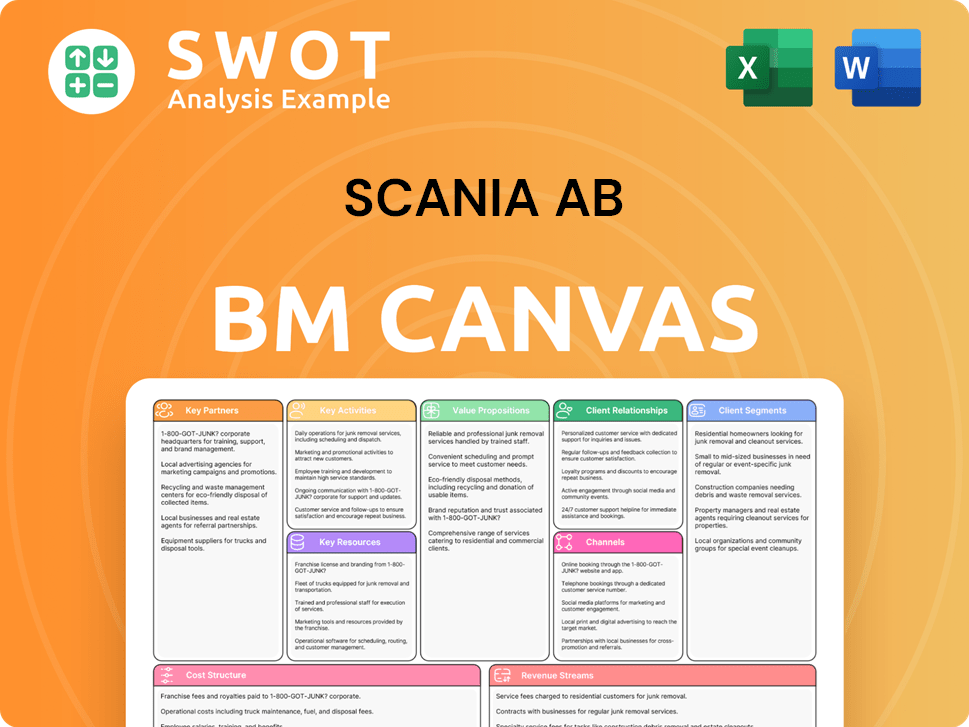
How Does Scania AB Win & Keep Customers?
Understanding the customer acquisition and retention strategies of a company like Scania AB is crucial for anyone analyzing its market position. The company's approach is multifaceted, combining traditional sales and marketing with digital strategies and a strong emphasis on after-sales service. This strategy is designed to not only attract new customers but also to foster long-term relationships, which is vital in the competitive commercial vehicle market.
Scania's success in the Trucking Industry and Commercial Vehicles sectors is significantly influenced by its ability to retain customers. This is achieved through an extensive service network, comprehensive service contracts, and data-driven customer relationship management. These elements work together to ensure high levels of customer satisfaction and loyalty, which are critical for maintaining a strong market share.
The core of Scania's strategy revolves around providing sustainable transport solutions, which is increasingly attractive to customers focused on Environmental, Social, and Governance (ESG) factors. The company's ongoing investments in new technologies, such as battery electric vehicles, further solidify its position at the forefront of industry innovation. For more insights, check out the Brief History of Scania AB.
Scania utilizes multiple marketing channels to reach its Customer Demographics. These include participation in industry trade shows, publications specific to the commercial vehicle sector, and a growing presence on digital platforms, especially professional networks like LinkedIn. This multi-channel approach ensures broad visibility and targeted engagement.
Direct sales teams play a crucial role in Scania's sales strategy. They work closely with clients to understand their specific operational needs. This allows for the customization of vehicle configurations and service packages, creating tailored solutions that enhance customer satisfaction and drive sales.
A comprehensive service network is central to customer retention. This network offers maintenance, repairs, and genuine parts, which minimizes vehicle downtime. Scania's commitment to providing excellent service is a key factor in building long-term customer relationships.
Service contracts are a cornerstone of Scania's customer retention strategy. These contracts provide customers with predictable operational costs and help ensure vehicle longevity. This predictability is a significant advantage for fleet managers and logistics professionals.
Scania leverages customer data and CRM systems to segment its customer base and personalize communications and service offerings. This approach allows for more effective targeting and enhanced customer satisfaction. Predictive maintenance, based on vehicle telematics data, is a key component of this strategy.
- Predictive maintenance helps Scania proactively address potential issues.
- Personalized service offerings improve customer satisfaction.
- Data-driven insights support strategic decision-making.
- Segmentation allows for targeted marketing efforts.
While not always formalized in the same way as consumer-facing businesses, Scania builds loyalty through strong relationships, consistent performance, and financing solutions. Scania AB Target Market appreciates the value of long-term partnerships.
Scania's focus on sustainable transport solutions is a powerful acquisition tool. This approach attracts customers committed to reducing their environmental impact. This aligns with the growing emphasis on ESG factors in corporate decision-making.
The company's continued investment in new technologies, such as battery electric vehicles, is a key acquisition strategy. This positions Scania at the forefront of the industry's transformation, appealing to forward-thinking customers. In 2024, the global electric truck market was valued at approximately $4.5 billion, and is expected to grow significantly.
Scania Financial Services provides financing solutions, which are integral to customer acquisition and retention. These services make it easier for customers to purchase and maintain vehicles, enhancing their overall experience. In 2024, the financial services segment contributed significantly to Scania's revenue.
Market Segmentation allows Scania to tailor its offerings and strategies to specific customer groups. This includes segmenting by industry, geographic region, and operational needs. This targeted approach improves the effectiveness of sales and marketing efforts.
Understanding Customer Purchasing Behavior is essential for Scania. This involves analyzing factors such as vehicle usage patterns, total cost of ownership, and the impact of environmental regulations. This analysis informs product development and sales strategies.
Scania AB Porter's Five Forces Analysis
- Covers All 5 Competitive Forces in Detail
- Structured for Consultants, Students, and Founders
- 100% Editable in Microsoft Word & Excel
- Instant Digital Download – Use Immediately
- Compatible with Mac & PC – Fully Unlocked
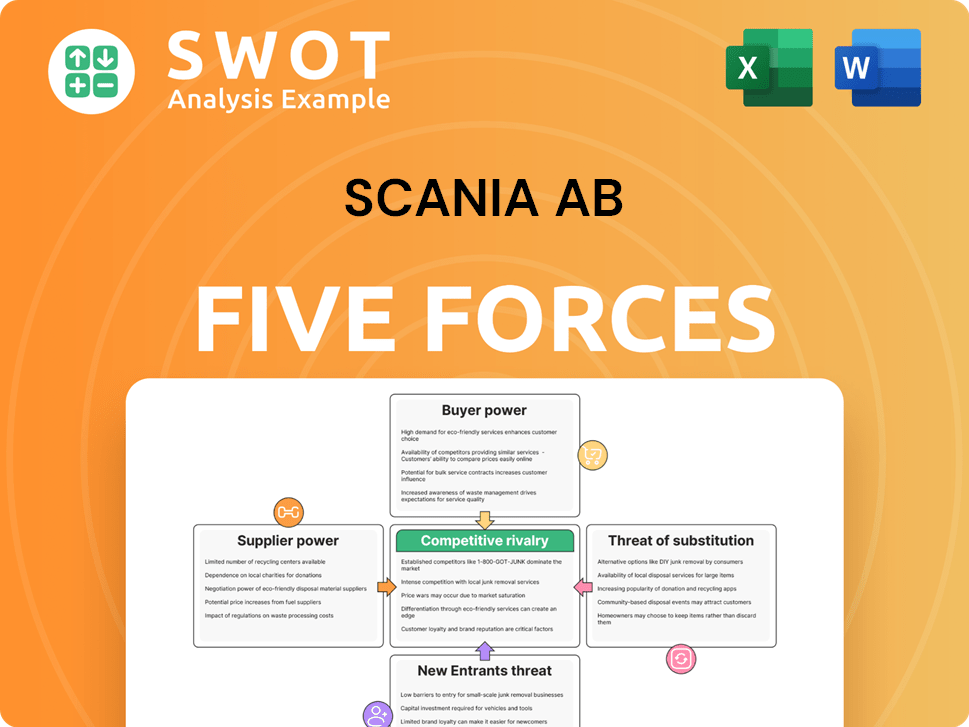
Related Blogs
- What are Mission Vision & Core Values of Scania AB Company?
- What is Competitive Landscape of Scania AB Company?
- What is Growth Strategy and Future Prospects of Scania AB Company?
- How Does Scania AB Company Work?
- What is Sales and Marketing Strategy of Scania AB Company?
- What is Brief History of Scania AB Company?
- Who Owns Scania AB Company?
Disclaimer
All information, articles, and product details provided on this website are for general informational and educational purposes only. We do not claim any ownership over, nor do we intend to infringe upon, any trademarks, copyrights, logos, brand names, or other intellectual property mentioned or depicted on this site. Such intellectual property remains the property of its respective owners, and any references here are made solely for identification or informational purposes, without implying any affiliation, endorsement, or partnership.
We make no representations or warranties, express or implied, regarding the accuracy, completeness, or suitability of any content or products presented. Nothing on this website should be construed as legal, tax, investment, financial, medical, or other professional advice. In addition, no part of this site—including articles or product references—constitutes a solicitation, recommendation, endorsement, advertisement, or offer to buy or sell any securities, franchises, or other financial instruments, particularly in jurisdictions where such activity would be unlawful.
All content is of a general nature and may not address the specific circumstances of any individual or entity. It is not a substitute for professional advice or services. Any actions you take based on the information provided here are strictly at your own risk. You accept full responsibility for any decisions or outcomes arising from your use of this website and agree to release us from any liability in connection with your use of, or reliance upon, the content or products found herein.